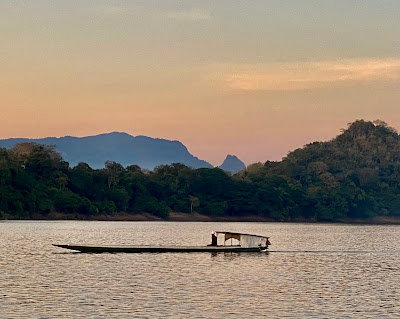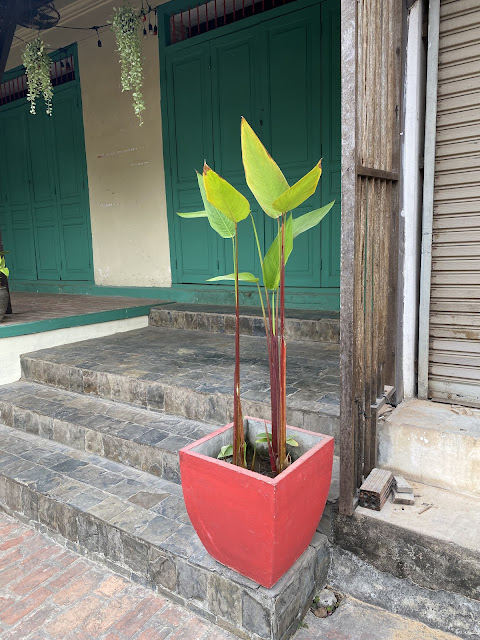 |
| Laos, "land of a million elephants" not sure how many are left in the wild, but a lot of them are on temples and public emblems. |
 |
| Vat Sisaket, one of the only temples that was not destroyed by the Siamese when they invaded and sacked Vientiane in the mid 19th century. |
 |
| As a former French colony, there are still many colonial style houses and buildings around. Some elderly still speak French but English and Chinese have become the main foreign languages. |
 |
| Khao Soi, typical Lao rice noodle soup. |
 |
| Sticky rice cooked in coconut water in bamboo. Great snack. |
 |
| Passion fruit, so cheap at the market. Sweet and tangy. |
 |
| These are amazing hand painted propaganda paintings made by villagers shortly after the revolution that Marion, the expat, had in her flat. |
 |
| Sunset over the Mekong (Thailand on the other side) |
Vientiane is like a medium sized Thai city, but from 50 years ago. There are not many tall towers and most of the architecture is quite old. There are several new Chinese built buildings in the suburbs, including the brand new train station, that brings a semi-high speed Chinese newly built train from Yunnan, China to Vientiane. Depending on the season, it used to take 10- 15 hours by a bad road to get to Luang Prabang, some 300 km north. However, with this train going through tunnel after tunnel, it's a quick two hours. So that's where I went next, to the famed ancient capital of Laos.
 |
| Traditional teak house on stilts. |
Luang Prabang, literally meaning "Royal Buddha Image", is on a peninsula at the confluence of the Nam Khan and Mekong rivers. It's well preserved architecture include temples and monasteries as well as French buildings from the 19th and early 20th century. It's well known for its rich cultural and religious heritage. I sort of compare it to what Kyoto is to Japan, Luang Prabang is to Laos. Every morning, hundreds of monks walk through the streets collecting alms. The city was formerly a capital of a kingdom of the same name. As well, a royal capital and seat of government of the Kingdom of Laos until the Pathet Lao communist takeover in 1975. Since the new Chinese train, it has become a lot more popular with tourists be it young backpackers or Chinese tour groups.
 |
| The shore of the Mekong are full of these long wooden boats, that take tourists out for sunset cruises. There is a lot of karaoke going on. |
 |
| The daily morning market, almost all food and another large evening market, mostly crafts and weavings. |
 |
| Laos is famous for its weaving. Beautiful silk and cotton scarfs, sarongs, sashes, with such intricate designs. |
 |
| I bought two cushion covers made from traditional Hmong hill tribe batiks on hemp. Beautiful natural dyes. |
 |
| Vat Xiang Thong, one of the oldest (1560) and most important Buddhist temples and monasteries in the country. Elegant lines. |
 |
| The Naga, divine water serpents represented in Hindu and Buddhist beliefs throughout Asia. They are incorporated extensively in Lao iconography and feature prominently in Lao culture. |
 |
| There are are also quite a few Thai tourists what with being next door with a similar culture and language. |
I decided to take a four hour bus ride north to a small town called Nong Khiaw for a couple of days. The road was pretty bad and it was in a cramped mini van full of backpackers. The town is on the Nam Ou river, which was the only way to get up there from Luang Prabang until seven years ago, when the Chinese built a dam on the river, then a road. It was nice to be in a small town with spectacular scenery of karst mountains covered in jungle.
I took a one day tour along with several other tourists (no large Chinese tours there yet, thankfully) which consisted of 2 hours motoring upstream in their long narrow boats. We then hiked to a large natural cave, which had served as a shelter for the local village from the relentless bombing by the Americans during the Vietnam war. (The Ho Chi Minh trail went through the Laotian jungle to bring weapons from the North to South Vietnam. More bombs were dropped on Laos than all of Europe in WWII!) The guide mentioned that until this day, they are still unexploded bombs that maim and kill villagers, even though the US govt. under Obama, provided millions for aid to find and detonate them (only 4 decades later... the least they could do). It's supposedly better now near and around villages. We continued on, back downstream, then stopped to walk through rice paddies and to a waterfall. The last part of the day they had plastic kayaks for us to paddle back for 1/2 hour into town.
 |
| Main Street |
 |
| The bridge is a hang out at sunset for locals and tourists. |
I returned by bus to Luang Prabang for one more night before getting a flight back to Bangkok, then a few days later, home. A great short trip to a region I had not been in a long time.




































